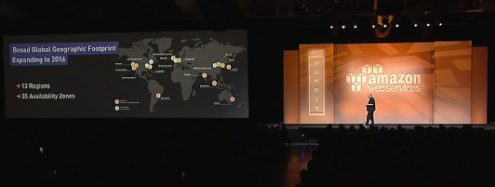Amazon, the company that has done more than any other vendor on the planet to define the cloud model, is now in the process of redefining that model with a new era of services. Werner Vogels, CTO of Amazon, helped to start the cloud revolution in 2006 when Amazon Web Services (AWS) was first launched. […]
Datamation content and product recommendations are
editorially independent. We may make money when you click on links
to our partners.
Learn More
Amazon, the company that has done more than any other vendor on the planet to define the cloud model, is now in the process of redefining that model with a new era of services.
Werner Vogels, CTO of Amazon, helped to start the cloud revolution in 2006 when Amazon Web Services (AWS) was first launched. Back then the primary services were EC2 (Elastic Compute Cloud) and S3 (Simple Cloud Storage Service). In a keynote at the AWS Summit on August 11, Vogels said that the shift in economic model, enabling organizations to shift computing costs from being a capital expenditure to an operational expenditure is the spark that truly ignited the cloud era.
Cloud Storage and Backup Benefits
Protecting your company’s data is critical. Cloud storage with automated backup is scalable, flexible and provides peace of mind. Cobalt Iron’s enterprise-grade backup and recovery solution is known for its hands-free automation and reliability, at a lower cost. Cloud backup that just works.
SCHEDULE FREE CONSULT/DEMO
“Nobody thinks about buying hardware anymore,” Vogels said. “There isn’t a vertical today that isn’t using AWS.”
While cloud offers a different model of consumption for compute resources, Vogels emphasized that AWS’ success today isn’t just about compute, but rather is about helping to enable digital transformation. The basic idea behind digital transformation is that organizations can move faster and be more agile in bringing new services and product to market.
“AWS is so much more today than just compute, storage, databases and networking,” Vogels said.
AWS now has services for analytics, security and event driven serverless models as well Lamda and Kinesis. While EC2 started off just offering Virtual Machines (VMs), AWS today enables multiple deployment models, including containers.
“We give you the tools to be successful in this world,” Vogels said.
Yet a large part of the economic utility that the cloud provides isn’t just about agility, it’s about the ability to shut services down that aren’t being used. Vogels emphasized that the cloud enables organization to reduce their expenses when they don’t need to use all the capacity. He added that eliminating wait states improves agility by enabling organizations to get up and running quickly and eliminating waste, by turning off resources that aren’t being used is just good economic sense.
“Agility doesn’t live in production, it lives in your development and test cycles,” Vogels said. “You can save up to 75 percent of your computing costs by switching off resources when developers go home.”
While Amazon started of with just a few U.S datacenters, today it’s a global business that is expanding its geographic footprint. Vogels said that he commonly sees developers work in one particular geography and then work to deploy in another.
To date in 2016, Amazon has launched two new AWS regions, one in South Korea and one in India. Four new AWS regions are set to be launched this year, including locations in a second region in China, a new region in Ohio, another in Montreal, Canada. At the beginning of 2017 a new region is planned for London, England.

Sean Michael Kerner is a senior editor at Datamation and InternetNews.com. Follow him on Twitter @TechJournalist
-
Ethics and Artificial Intelligence: Driving Greater Equality
FEATURE | By James Maguire,
December 16, 2020
-
AI vs. Machine Learning vs. Deep Learning
FEATURE | By Cynthia Harvey,
December 11, 2020
-
Huawei’s AI Update: Things Are Moving Faster Than We Think
FEATURE | By Rob Enderle,
December 04, 2020
-
Keeping Machine Learning Algorithms Honest in the ‘Ethics-First’ Era
ARTIFICIAL INTELLIGENCE | By Guest Author,
November 18, 2020
-
Key Trends in Chatbots and RPA
FEATURE | By Guest Author,
November 10, 2020
-
Top 10 AIOps Companies
FEATURE | By Samuel Greengard,
November 05, 2020
-
What is Text Analysis?
ARTIFICIAL INTELLIGENCE | By Guest Author,
November 02, 2020
-
How Intel’s Work With Autonomous Cars Could Redefine General Purpose AI
ARTIFICIAL INTELLIGENCE | By Rob Enderle,
October 29, 2020
-
Dell Technologies World: Weaving Together Human And Machine Interaction For AI And Robotics
ARTIFICIAL INTELLIGENCE | By Rob Enderle,
October 23, 2020
-
The Super Moderator, or How IBM Project Debater Could Save Social Media
FEATURE | By Rob Enderle,
October 16, 2020
-
Top 10 Chatbot Platforms
FEATURE | By Cynthia Harvey,
October 07, 2020
-
Finding a Career Path in AI
ARTIFICIAL INTELLIGENCE | By Guest Author,
October 05, 2020
-
CIOs Discuss the Promise of AI and Data Science
FEATURE | By Guest Author,
September 25, 2020
-
Microsoft Is Building An AI Product That Could Predict The Future
FEATURE | By Rob Enderle,
September 25, 2020
-
Top 10 Machine Learning Companies 2021
FEATURE | By Cynthia Harvey,
September 22, 2020
-
NVIDIA and ARM: Massively Changing The AI Landscape
ARTIFICIAL INTELLIGENCE | By Rob Enderle,
September 18, 2020
-
Continuous Intelligence: Expert Discussion [Video and Podcast]
ARTIFICIAL INTELLIGENCE | By James Maguire,
September 14, 2020
-
Artificial Intelligence: Governance and Ethics [Video]
ARTIFICIAL INTELLIGENCE | By James Maguire,
September 13, 2020
-
IBM Watson At The US Open: Showcasing The Power Of A Mature Enterprise-Class AI
FEATURE | By Rob Enderle,
September 11, 2020
-
Artificial Intelligence: Perception vs. Reality
FEATURE | By James Maguire,
September 09, 2020
SEE ALL
CLOUD ARTICLES




